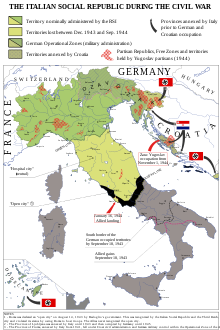| Axis war crimes in Italy | |
|---|---|
| Part of Mediterranean theatre of World War II | |
 | |
| Location | Italian Social Republic |
| Date | 8 September 1943 – 8 May 1945 |
| Target | Italian JewsItalian civilian populationItalian military internees |
| Deaths | Italian Jews 8,000Italian civilian population 14,000Italian military internees 40,000 |
Two of the three major Axis powers of World War II—Nazi Germany and their Fascist Italian allies—committed war crimes in the Kingdom of Italy.
Research funded by the German government and published in 2016 found the number of victims of Nazi war crimes in Italy to be 22,000, double the previously estimated figure. Most victims were Italian civilians, sometimes in retaliation for partisan attacks, and Italian Jews.[1] This figure does not include Italian military internees: approximately 40,000 of them died in German captivity.[2]
The above estimate excludes the estimated 30,000 Italian partisans who were killed during the war. [clarification needed].[3]
The killing of Italian civilians by frontline units of the Wehrmacht and SS has sometimes been seen as stemming from a sense of betrayal the Germans felt due to the Italian surrender; and by a feeling of racial superiority. However, some historians have argued that the reasons for atrocities and the brutal behaviour were more complex, often resulting from the military crisis caused by the German retreats and the fear of ambushes.[3]
Only a few perpetrators were ever tried for these war crimes. Few of these served prison sentences because of Germany's refusal to prosecute and extradite war criminals to Italy.[1] The Italian government, in the early postwar decades, also made little effort to bring German war criminals to justice by demanding extradition: it feared that such demands would in turn encourage other countries to demand the extradition of Italian citizens accused of war crimes committed while Italy was allied with Nazi Germany.[4]
- ^ a b Armellini, Arvise (5 April 2016). "New Study: Number of Casualties in Nazi Massacres in Italy Nearly Double as Previously Believed". Haaretz. Retrieved 16 August 2018.
- ^ "8. September 1943: Die italienischen Militärinternierten". Zwangsarbeit 1939–1945 (in German). Retrieved 21 August 2018.
- ^ a b Neitzel, Sönke. "Book Review by Sönke Neitzel in War in History: Wehrmacht und Waffen-SS im Partisanenkrieg: Italien 1943–1945". University of Cologne. Retrieved 16 September 2018.
- ^ Wiegrefe, Klaus (19 January 2012). "How Postwar Germany Let War Criminals Go Free". Der Spiegel. Retrieved 17 August 2018.
© MMXXIII Rich X Search. We shall prevail. All rights reserved. Rich X Search
